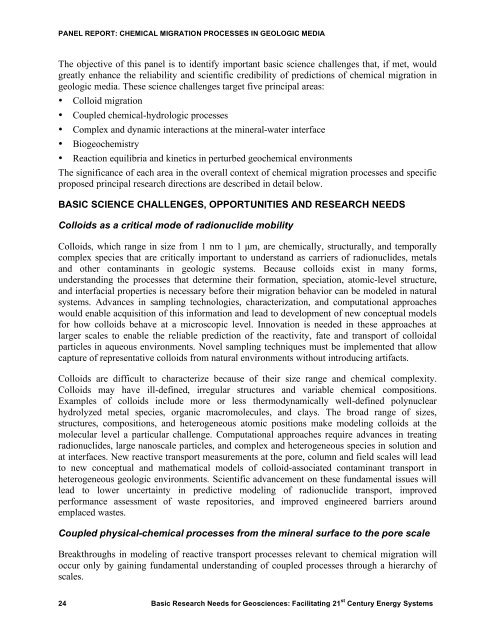Basic Research Needs for Geosciences - Energetics Meetings and ...
Basic Research Needs for Geosciences - Energetics Meetings and ...
Basic Research Needs for Geosciences - Energetics Meetings and ...
- No tags were found...
Create successful ePaper yourself
Turn your PDF publications into a flip-book with our unique Google optimized e-Paper software.
PANEL REPORT: CHEMICAL MIGRATION PROCESSES IN GEOLOGIC MEDIAThe objective of this panel is to identify important basic science challenges that, if met, wouldgreatly enhance the reliability <strong>and</strong> scientific credibility of predictions of chemical migration ingeologic media. These science challenges target five principal areas:• Colloid migration• Coupled chemical-hydrologic processes• Complex <strong>and</strong> dynamic interactions at the mineral-water interface• Biogeochemistry• Reaction equilibria <strong>and</strong> kinetics in perturbed geochemical environmentsThe significance of each area in the overall context of chemical migration processes <strong>and</strong> specificproposed principal research directions are described in detail below.BASIC SCIENCE CHALLENGES, OPPORTUNITIES AND RESEARCH NEEDSColloids as a critical mode of radionuclide mobilityColloids, which range in size from 1 nm to 1 μm, are chemically, structurally, <strong>and</strong> temporallycomplex species that are critically important to underst<strong>and</strong> as carriers of radionuclides, metals<strong>and</strong> other contaminants in geologic systems. Because colloids exist in many <strong>for</strong>ms,underst<strong>and</strong>ing the processes that determine their <strong>for</strong>mation, speciation, atomic-level structure,<strong>and</strong> interfacial properties is necessary be<strong>for</strong>e their migration behavior can be modeled in naturalsystems. Advances in sampling technologies, characterization, <strong>and</strong> computational approacheswould enable acquisition of this in<strong>for</strong>mation <strong>and</strong> lead to development of new conceptual models<strong>for</strong> how colloids behave at a microscopic level. Innovation is needed in these approaches atlarger scales to enable the reliable prediction of the reactivity, fate <strong>and</strong> transport of colloidalparticles in aqueous environments. Novel sampling techniques must be implemented that allowcapture of representative colloids from natural environments without introducing artifacts.Colloids are difficult to characterize because of their size range <strong>and</strong> chemical complexity.Colloids may have ill-defined, irregular structures <strong>and</strong> variable chemical compositions.Examples of colloids include more or less thermodynamically well-defined polynuclearhydrolyzed metal species, organic macromolecules, <strong>and</strong> clays. The broad range of sizes,structures, compositions, <strong>and</strong> heterogeneous atomic positions make modeling colloids at themolecular level a particular challenge. Computational approaches require advances in treatingradionuclides, large nanoscale particles, <strong>and</strong> complex <strong>and</strong> heterogeneous species in solution <strong>and</strong>at interfaces. New reactive transport measurements at the pore, column <strong>and</strong> field scales will leadto new conceptual <strong>and</strong> mathematical models of colloid-associated contaminant transport inheterogeneous geologic environments. Scientific advancement on these fundamental issues willlead to lower uncertainty in predictive modeling of radionuclide transport, improvedper<strong>for</strong>mance assessment of waste repositories, <strong>and</strong> improved engineered barriers aroundemplaced wastes.Coupled physical-chemical processes from the mineral surface to the pore scaleBreakthroughs in modeling of reactive transport processes relevant to chemical migration willoccur only by gaining fundamental underst<strong>and</strong>ing of coupled processes through a hierarchy ofscales.24 <strong>Basic</strong> <strong>Research</strong> <strong>Needs</strong> <strong>for</strong> <strong>Geosciences</strong>: Facilitating 21 st Century Energy Systems
















